Whether you’re on your first date or your relationship is a decade old, It’s never a good idea to keep yammering on about yourself all the time. Now, what is Content curation Marketing? Content curation marketing is the same except, your prospects are your dates, and you’ve to make them feel special. Of course, that won’t happen if you talk about your brand only. But it would if you curate relevant content for them and keep them engaged.
60% of marketers are devoted to creating at least one piece of content daily.
In fact, 85% of the B2B marketers credit curated content for their content marketing success.
In this post, let’s dive into the nuts and bolts of content curation, what it is, what benefits it brings to the table, and the steps to take to curate content for your brand.
Let’s roll!
What is content curation?
The act of selecting, gathering, structuring, and distributing content from various sources on the internet is known as content curation. Curated material, such as “best of” lists or content tailored to assist someone master a specific skill, usually provides a list of high-quality resources on a given topic.
Discover, brand, and share the best content with your audience. Establish yourself as an authority and turn leads into loyal customers.
Build Trust with Curated Content
Now, it’s extremely important to bust this common content curation myth – the process isn’t a time-saving alternative to content creation.
Heidi Cohen, a global marketing influencer, writing in Content Marketing Institute, defines content curation as,



You’ll understand each of these pointers in-depth as we proceed. For now, let’s dissect Heidi’s definition of content curation.
She starts with “to meet your audience’s information needs…” Undeniably, you can’t meet all of your audience’s (massive) content needs. But you can always substitute their hunger for new content by sharing relevant content with them.
Next up, the definition reads “…content curation is the assembly, selection, categorization, commentary, and presentation…”
Why Content Curation is Important
Content curation is important because it allows you to collect and organize information from multiple sources into a single, coherent package. This can be incredibly useful when trying to research a topic or learn more about a particular subject. By curating content, you can save time and effort while still getting all of the information you need.
By gathering relevant content for your audience, publishing it on your website, and syndicating it across other sites, you can attract more visitors, increase engagement, and generate leads.
When you curate content that is helpful and relevant to your target audience, it helps to create an emotional connection with your readers. Emotional connections lead to trust, which is essential to building a long-lasting relationship between your brand and your readers. If you have been collecting and publishing the right content, your readers will come back to your site time and time again.
There are many different ways you can use content curation to help your business, such as: –Increasing website traffic; – Generating leads for your business, – Developing brand awareness.
5 Major Steps to Content Curation
1. Assembly
Gathering content for your audience that lies within your field and interests your readers.
2. Selection
Not all sourced content is relevant or share-worthy enough. Here’s where you set up filters and wear the approve-this-disapprove-that hat.
3. Categorization
Content comes in different formats, including blog posts, infographics, eBooks, and more. It also goes out to different distribution channels such as social media, newsletters, blogs, and so on. At this point, you decide which content will go where for optimal engagement.
4. Commentary
As we just discussed, curation is not copy-pasting and posting a link to your social media. Instead, it’s adding your take on the matter as well. Like here:



5. Presentation
Giving the content, you share a visual makeover. For instance, you share data that someone else has churned out but put in a graphic. For Example, CoSchedule took data from Convince & Convert and put it in a graphic that represents their brand style.
Heidi summarizes the definition with “…of the most relevant quality information.” In other words, you are to curate and share content that offers relevant and quality insights.
Seasoned marketers also use content curation to fill in gaps in their social media stream. Here are 10 frequently asked questions by content marketers about content curation.
You can either watch the video for FAQ’s about curated content or keep scrolling:
What is content curation marketing?
Content curation marketing is the strategy used in content marketing to accomplish the content production frequency and demands every day. In this, the editor gathers the best, and relative content from various source provides his valuable insight on it, and share it with his audience. This content curation marketing strategy is used when there is no time to publish fresh content.
Is content curation legal?
As long as you mention or cite the source you curated content from, it’s legal. Using someone else’s content as your own is what’s illegal. Whereas content curation marketing is combining the best resources out there and using them as a reference to make your blog interesting for your audience. Therefore we can’t call content curation illegal, scrapping, or copying.
Many popular businesses and websites like Huffington Post use Content curation marketing as their primary marketing strategy with a set of rules to keep it legal and make Content curation work.
How does Content Curation work?
1. Link Original source of Content
Taking credit for the original content is not ethically correct and not in the eyes of Google. To not look like a plagiarist, quote, add a reference, or Link to the original content source.
2. Add value to the curated content
Copying content from the internet alone is of no use to you if you don’t give your insights about it. Share some related and valuable information to the curated text for it to be ranked in SERPs.
3. Use content curation tools
Content curation tools help you find relative and trendy content based on your search. You can also find influencers to quote or tweets to share in the RSS feed! Some of my favorite content curation tools are:
- Content Studio
- Flip Board
- Feedly
Find and Curate content to increase engagement on social media. Try App For free!
What is the difference between content curation and creation?
Essentially, content curation relates to finding, filtering, and sharing relevant content created by others with your audience. On the other hand, content creation is what it sounds like – creating new content for your audience. However, at the center of this content is your product or service and how it can help solve your audience’s problems.



Content curation examples – let’s breathe more sense into the process
With the definition out of the way, you’d probably be wondering, ‘so where can I use curated content, or what is an example of content curation?’ Answer: On every channel where you connect with your audience.
So that’s newsletters, podcasts, blog posts, social media, and even your eBook. Hard to believe? Let’s weave in some examples of curated content:
1. The Five Things on Friday Newsletter by James Whatley
Whatley shares the news with his readers but also adds content that he has read and found interesting, alongside sharing his opinion on the matter.
Here’s a section of one of his newsletters:



See how the curated link is tucked into James’s opinion – he doesn’t like the “ugly-chic shoe” but finds the stories/interviews “a gold mine of excellence.” There you go! A perfect example of content curation.
There are more links + James’ insight at the end of this newsletter:



2. Our curated blog post
We gathered advice from content marketing influencers and put it all into one mighty piece. Note how we brushed up the content’s presentation too.
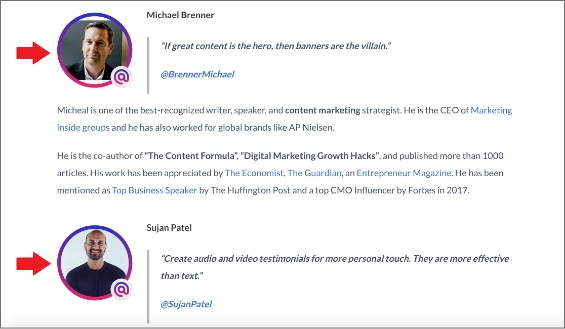


Read-Up: Time-Tested and Golden Words of advice by 40 Content Marketing Influencers
3. Content Marketing Academy’s lessons from an eBook
In this post, Melissa Coombs curates lessons that she learned from Marcus Sheridan’s eBook, Inbound and Content Marketing.



4. Social Media Today curating relevant content from across the web
Social Media Today is a leading source of social media news, tips, and trends. Head over to their site, and you’d see it is dedicated to curated news.
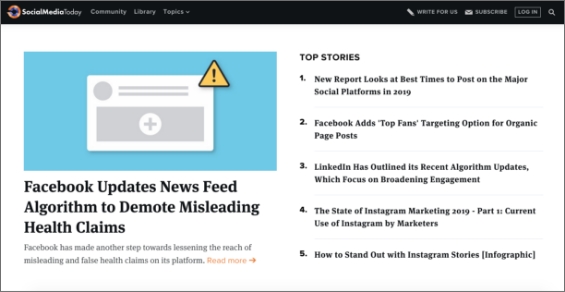


Each post gives bites of industry news with the author’s quick take on the matter. Here’s the fifth one from the list:
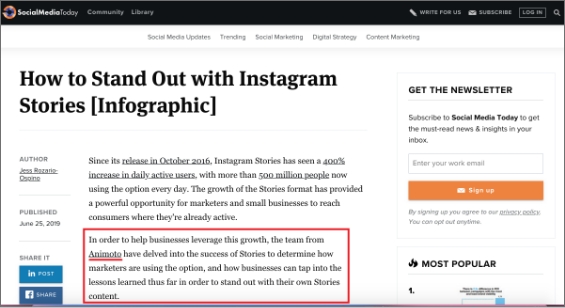


This piece curates an infographic from Animoto and offers it to their audience with their personal opinion as shown on the screen. Most importantly, the information is presented in Social Media Today’s style.
What are the benefits of Content curation?
Some of the benefits of content curation are obvious. You get to supplement the content that you create with the content you curate. Other benefits, however, go deeper.
Let’s explore each:
Curated content brightens your content feed
There are two ways gathered content can brighten your content feed, whether it’s your social media or blog feed:
Firstly, curated content adds variety by switching the self-centered tone with a community-based one. So you’re not the child in the neighborhood who only natters about himself but the child who is friends with everyone, following the ‘sharing is caring’ agenda.
Secondly, you can add a variety of opinions and voices to your content. This variety can help diversify your content mix, such as how we noted in the Social Media Today post where they added an infographic to their content.
Curated content creates an impression of your business
The content that you serve your audience tells them what your business covers. For instance, it doesn’t make sense for a stationary brand to share a post on essentials to take on your trip to XYZ country.
Therefore, by sharing relevant content, you give your target audience a quick idea of what you are talking about.



It helps you grow your network
There are two ways to grow your network with curated content:
One, you write a post by curating opinions from influencers in the industry. For example, LeadTail reached out to 11 social media practitioners for their opinion on what would happen if social removed the like button and put it in their blog post – a classic example of curated content



While the reader gets to read opinions from others, the behind-the-scenes case is different. Imagine this with me for a second:
Step 1: The curator reaches out to influencers and asks for their quotes.
Step 2: The influencers feel honored and share their insights.
Step 3: The curator publishes the post and tags all the influencers who, in turn, also share the post
Social platforms may hide or remove Likes. Reactions:@JenBridgesRD ????????@mandymenaker ????@VanellaGroup ????@SFerika ????@elenacsalazar ????????@amberlydressler ????@ldimyadi ????????@inkandcopy ????@southbaysome ????@MiikoMentz ????@sageandsavvy ????????https://t.co/8E24eNV0rd via @Leadtail
— Dennis Shiao ✍️ (@dshiao) June 27, 2019
See what happened there? The post got a good reach and several shares, and the curator also developed a relationship with the influencers. At some point, these influencers will also return the favor and ask the curator for a quote or so (hint: the law of reciprocity is at work here).
Two, you share someone else’s post, say on your social channel, and tag them. Like this:
“In the absence of focus, we’re unable to carry out high-leverage activities that add value to the world” – The Complete Guide to Deep Work https://t.co/1LN0MXjBwd via @doist #CalmWork #DeepWork #Productivity
— Noisli (@noisli) May 29, 2019
Of course, when you tag the author for crediting him for his content, he will likely respond to you. This gives you another chance to nurture relationships in your field. Besides, there are odds that the person you tagged shares your content in return.
Curated content keeps the conversations going
Content is a way to converse and engage with your audience while delivering value. That’s how content converts and turns leads into customers. However, there’s an extent to how much original content you can create.
So you need to add relevant curated content in the mix to keep the party going. It will encourage communication and make sure your content planner isn’t empty at any point. Choose the content that sparks conversations so your audience jumps in and engages with you.
Here’s an example of curated content in RescueTime’s newsletter.
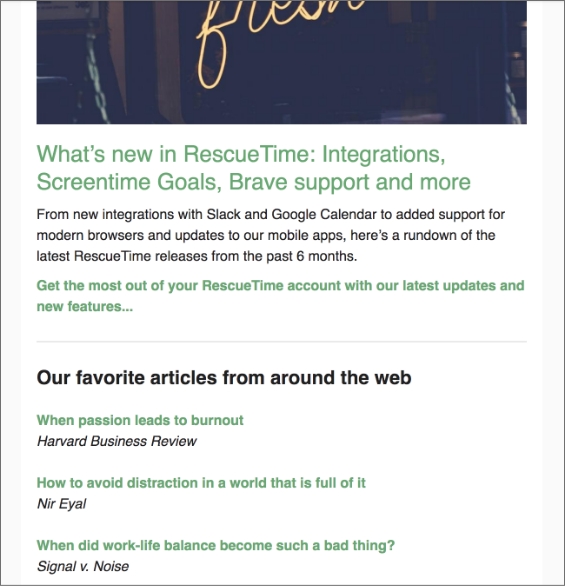


The letter adds curated content at its end. Each of these pieces is valuable to their audience that wants to sharpen its productivity. So they’re relevant, helpful, and can prompt a conversation if their readers read and discuss any of the articles.
There’s another advantage here – you can learn what excites your audience. A topic that attracts lots of readers and engagement is a topic that interests your audience. If you find any holes in it, you can create content around it.
The shared content sets you up as a thought leader
When you add your point of view, you’re putting yourself forward as a thought leader. Done consistently, your readers will start anticipating your opinion on the matter, which pitches you forward as a voice in your industry.
Content and SEO need each other. A single piece of high-ranking content can drive traffic to a site for years to come.@databoxHQ shares tips to help you create the content your audience can’t wait to read → https://t.co/RA8dGv2Wbm pic.twitter.com/3n3fRoa7h5
— Andy Crestodina (@crestodina) July 3, 2019
Curated content also helps you stay on top of the industry trends
Here’s another incredible plus, content curation gives you a scoop on what’s going on in the industry. For instance, if you’re targeting a keyword and gathering content on it, let’s say, ‘content marketing,’ you’d note what other people in your industry are publishing.
In addition to staying well-informed and abreast of the trends, you can identify gaps in the information stream. With all the influx of content, spot blind spots, and create content to fill these blanks.
Curated content helps improve your ranking too
Remember, content curation is not copy + paste. It’s adding value. And when you do so, you can improve your ranking in the search engine too. Hard to swallow? Folks over at Bruce Clay Inc. were equally curious, so they ran a test.
They learned that when they shared curated content minus any value from their side, the ranking dipped from fourth place to tenth. However, the good news is when they published excerpts with their links and summary, their ranking shot to the first spot on the browser.



How to curate content? 8 steps to follow in content curation
With over 7 million blog posts going out every day, it’s your responsibility to only offer content that is:
- High-quality
- Relevant
- Offers a topping of extra value
But the question is, how should you get started? The simple answer is a plan, just like we have a social media marketing strategy! Keep in mind that without a strategy, your efforts will be all over the place, which wouldn’t be any help in reaping the merits of content curation.
1. Start with setting your objectives
First, you must be clear about how much-curated content you want to add to your feed. There’s no hard and fast rule to observe, but you’ll have to be clear about the ratio before you start curating.
For instance, try a ratio of 75% of original content and 25% of curated content. You will have to set these ratios per the sharing channel. So you may add more curated content to your Twitter account than your blog.
2. Select what you can share
Before sourcing content, you need to be clear about what content format you’re looking for. It’s one thing to know your target keyword(s), but it’s another to be sure of the type of content you want to add to your content mix.
You have a variety to choose from:
- eBooks and guides
- Research, reports, and white papers
- Statistics
- Slideshare presentations
- Videos, diagrams, and infographics
- Lists, how-to guides, and tips
3. Up next, pick your sources
The content that you are looking for won’t come magically to you. You’ll have to pick your binoculars and look far and wide. Alas, the internet is a vast expanse, and you can’t possibly look for everything all by yourself. You can also discover content with the help of tools.
Following your favorite social media channels to get a steady stream of content updates is an effective way to curate content. However, keeping track of all the accounts you follow can quickly become tedious. It is here that Twitter lists can come to your rescue.
Create a list of accounts whose content you don’t want to miss, such as how Brian Fanzo does below. Visit your lists regularly to cherry-pick content to share with your audience.
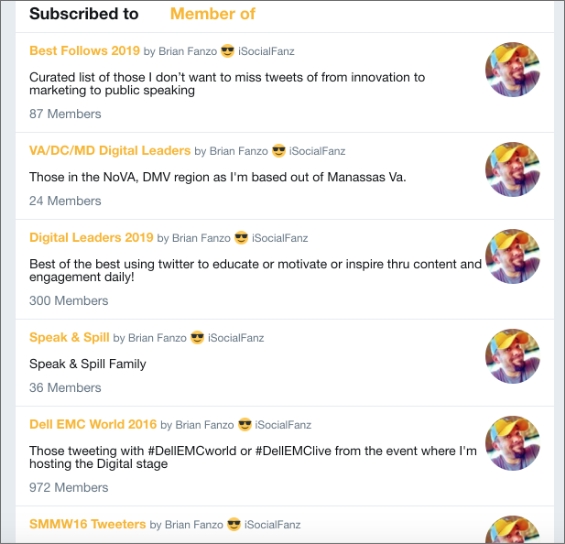


Newsletters
This is as simple as subscribing to your industry’s newsletters and gathering content from there to share with your audience.
Google Alerts
You can also set up Google alerts to get a hold of the specific content you want to curate. Setting alerts begins with entering a search term in your browser and narrowing your search to a specific language, source, and/or region.
Industry blogs and magazines
Subscribe to industry blogs and magazines or add them to your RSS feed to get a sea of relevant content for your target readers.
This entails adding keywords to Flipboard and letting it regurgitate relevant content for you. Here’s a screen showing Flipboard delivering results for multiple keywords, including small business marketing, blogging, video marketing, etc.
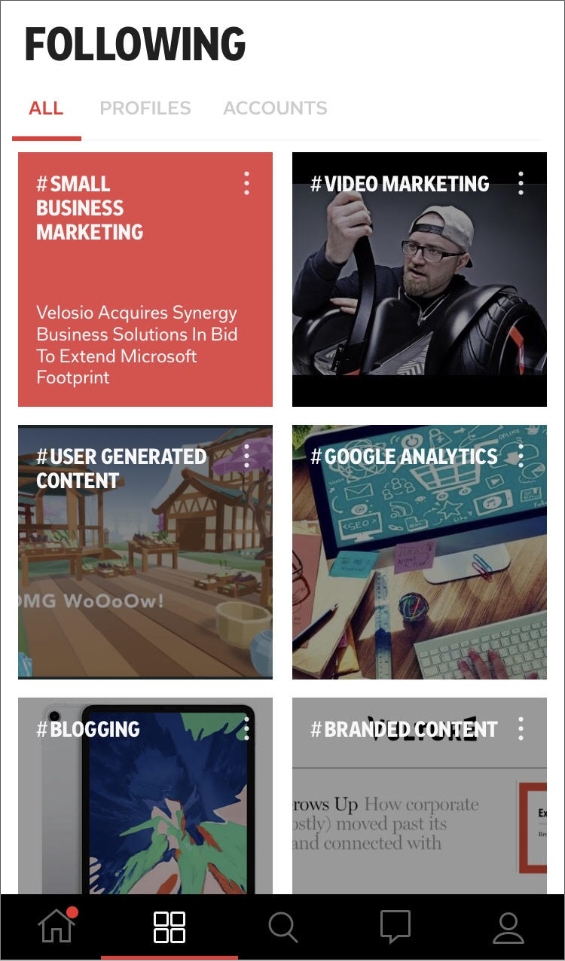


Shortcut: Use a content curation tool such as ContentStudio. Start by entering your keyword in the query box. You can also look at authors, hashtags, and domains.
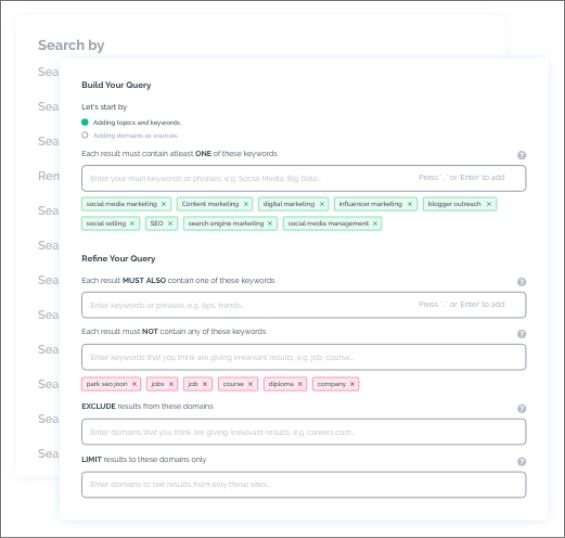


Add other details, so you know the content you need to curate. Next, get the results with a trending score.
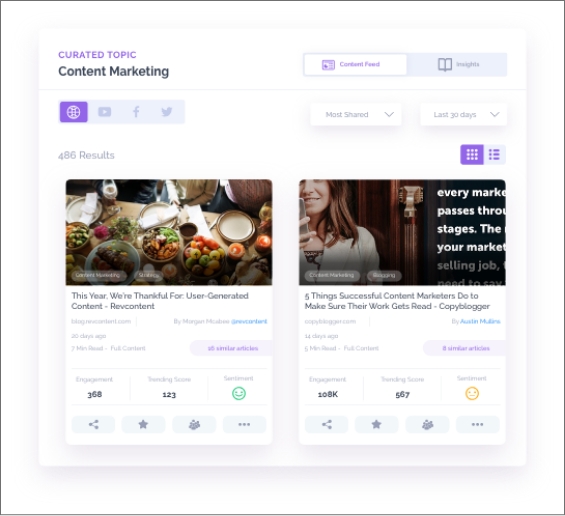


4. Filter the content
Naturally, all the content that you collect won’t be a good fit for your audience. Some pieces may not be relevant to their interests. Although there are many ways to drive your engagement, other pieces may not end up doing that for you.
At this step, ask yourself the following questions before nodding yes in favor of a content piece:
- How would this content help my audience?
- Is it unique and share-worthy?
- Does it come from a trustworthy source?
- Would it encourage the reader to engage with me?
You can also prepare a checklist of these pointers and only admit content into your curated folder once it checks off all the points.
5. Add value to the content you’re aiming to share
We’ve talked about this before but let’s refocus on this point: content curation is not copy + paste. If anything, it’s offering value to your audience. Therefore, you are going to be adding value or adding your personal spin to the content you share here.
The pieces that Databox creates are incredible examples. Here’s one of the posts:
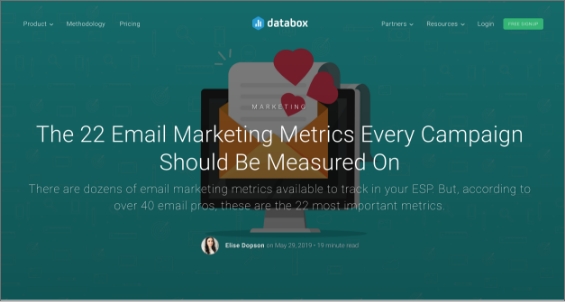


It asks 40 email experts for the email marketing metrics (as discussed in the post) that they track but distills the curated answers into 22 KPIs (as mentioned in the headline) alongside great insights from the writer.
In addition to this method of adding originality, you can try the following steps:
- Pack the information into an infographic
- Extract information from videos
- Add additional information on the topic
- Share the major takeaways from a book or video and give your opinion on it
6. Decide the channel the curated piece will be shared on
How you add your spin to the content you share depends on the medium on which you share it. The Databox example above is best when curating content for your blog or eBook.
Similarly, you can pull out quotes or statistics from the piece you share on social media. This goes without saying, but you can share curated content on your:
- Social media channels
- Newsletter
- Blog
- eBook
7. Add to the aesthetics
The work that goes into this step also depends on the channel you are sharing your curated content on. A newsletter, for instance, demands a complete aesthetics makeover therefore, create one using email newsletter software. You can prepare new graphics for sharing curated content on social or your blog.
The Brain Pickings newsletter, for instance, has a bright look and shares curated content if you look closely in the screengrab:
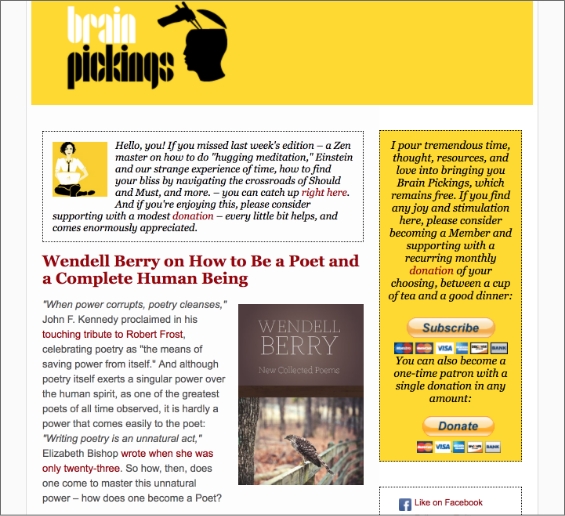


8. Analyze your content to optimize it
Lastly, just as with any other content you create, curated content must be analyzed. This helps you see how it is performing. Put simply, you need to keep your eyeballs on how well your audience responds to the content you share and optimize your efforts accordingly.
To this end, check your blog and social media analytics to see how your curated content is doing. If there’s a post that doesn’t perform well, you’ll know that it doesn’t resonate with your audience. Use this data to curate further.
Bonus – Think about how you can involve the community
A crucial aim of content curation is engaging the community as Clay Shirky, NYU professor, shared with the Fast Company, curation “isn’t just about information seeking, it’s also about synchronizing a community.”
Here’s how:
i. You share content from others to involve a part of the community.
ii. The content that you share encourages others to engage with you, helping nurture relationships with the community you’re building.
iii. You can take this further and involve the community in content curation
Let’s illuminate this last point with an example. Spin Sucks has two weekly columns packed with curated content, Gin and Topics for YouTube videos and The Big Question. For gathering content, Spin Suck’s social and Slack communities are used.
Not only does this strategy help cut short the content curation cycle, but it also curates content that appeals to your community and involves them.
Content curation tools
1. ContentStudio


Content curation for discovering and publishing trending third-party content is a great way to boost conversions. ContentStudio is your go-to content curation tool to maintain your publishing flow. You can quickly stack up engaging and relevant content with ContentStudio. Besides providing unique, relevant content for your audience, ContentStudio helps you optimize your content to share on social media and your blog, so you can grow your influence. Some of the fantastic content curation features the tool offers include:
Share and discover trending content: Discover trending material and maintain a steady stream of curated content by utilizing the powerful Content Discovery module. It ensures that the most relevant content is available through a sophisticated scoring algorithm. You can boost traffic and conversions by instantly curating, publishing, and promoting.
Monitor content by keywords, topics or sources of your interest. Curate content that drives engagement on all of your channels.
Discover Relevant, Trending And Engaging Content
Evergreen content ideas: There are around 500 topics in ContentStudio that cover almost every industry and interest to make your life easier. View relevant articles on topics that interest you every day. The ones that best align with your business and promise to drive engagement are the ones you want to choose. Curate content your audience will love.
Highly targeted custom topic feeds: Using ContentStudio’s Query Builder, create a custom topic feed to find curated content. A highly targeted custom topic feed can be created using boolean AND, OR, and NOT operations. Include or exclude keywords and domains when creating your custom topics.
Cover stories: Sharing content on social channels can be simplified with ContentStudio. Cover Stories gives you access to the top five trending stories for each topic you curate. You can keep your posting game on point with instant access to viral content.
2. BuzzSumo
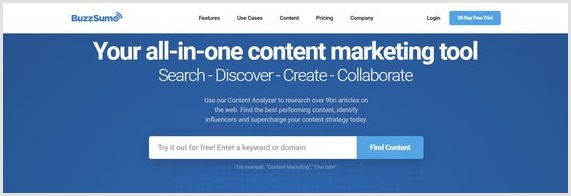


One of the most widely used tools for content curation is Buzzsumo, which may help you find some material that resonates with your audience. To get a list of the most popular content on a particular topic, enter a keyword or domain name.
The list may then be sorted according to criteria including date, content category, viewing backlinks, following authors, and more. All the exhibited articles have already resonated strongly with your target audience and are thus good inputs to your content marketing plan.
3. ShareIt
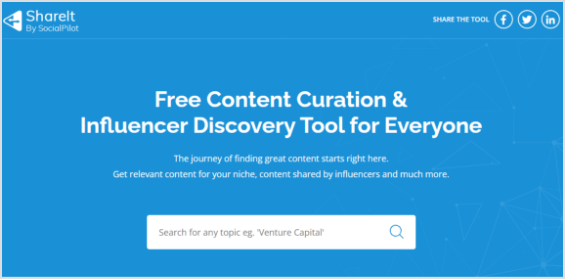


For bloggers and social media teams, ShareIt is a free content curation and influencer-finding tool. Simply entering a keyword is all that is required. ShareIt will compile a list of relevant content and social media accounts.
These pieces of content are provided in various formats, including blogs, videos, and others. It offers a separate option for influencers that gives you a list of influential people and well-known websites related to your search. By providing social network sharing buttons next to each content suggestion, ShareIt also enables you to post content directly to your accounts.
4. Google News Alert



Google Alerts being old serves the purpose well. allows you to enter any topic or name and receive email notifications anytime there is new information.
Google Alerts can monitor mentions of your business name or, less tacky, those of your rivals. Also, keep up with popular news in your area by browsing for phrases like “social media marketing.”
5. Feedly



If you work in marketing, you know how crucial it is to stay ahead of the curve with news in your field, pay attention to what industry experts say, and monitor social media trends. Checking multiple sources for this purpose becomes challenging for a busy marketer.
Feedly is a good enough platform as it gathers content from your preferred sources and presents it for you to effortlessly access. You may organize content from magazines, tweets, YouTube channels, blogs, RSS feeds, and particular keywords.
6. Flipboard



Flipboard is a great content curation tool accessible on desktop and mobile devices. You can curate content for your audience to capture their interest and keep them hooked. It is an easy-to-use application that enables you to make a mini-magazine for your audience.
The simple and quick design makes it easier to emphasize the content. You can also include videos, play music, and read text-based material. All you have to do is simply choose the categories that interest you and sign up for preferred sources for customized curation.
Wrapping up
Curating content adds variety to your content mix while satisfying your target audience’s content appetite. With all the information that we’ve covered in this blog post, you should be all set to gather and share valuable content that resonates with your audience. One last parting tip – make sure your curation efforts are consistent and relevant.
Read More: How To Become a Pro at AI-Generated Content
Masooma Memon
Masooma Memon is a pizza-loving freelance writer by day and a novel nerd by night. She crafts research-backed blog posts and articles for small businesses and app companies who aim to employ quality content to educate and engage with their audience.






